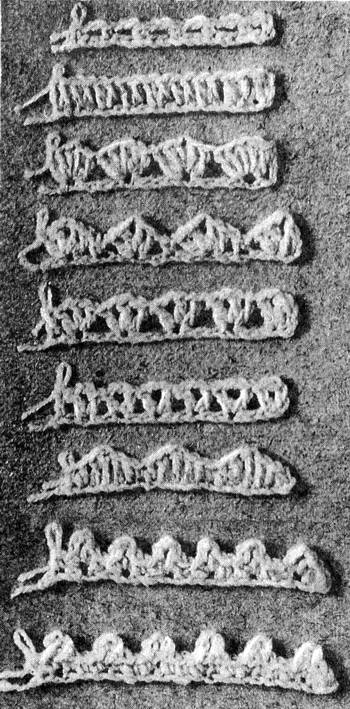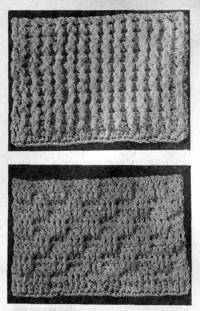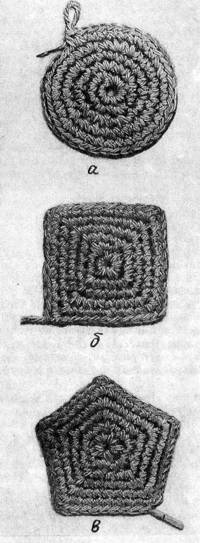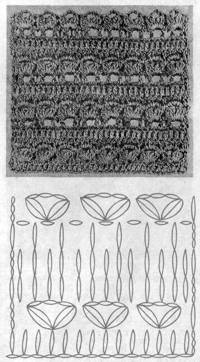Patterns of crocheting
The piece of a knitted cloth consists of the patten strips (numbers), located one above another. At performance of a product numbers can be knitted in one direction on a circle (takes, a stocking) or in two directions — direct and return (scarf). The numbers of a pattern going in direct and return directions, do as follows. Having knitted 1-st number on loops of a chain, a product turn a seamy side to itself and carry out 2-nd number on columns and loops of 1-st of some.
Carrying out patterns the numbers going in one direction (on a circle), each new number begin after 1-st and last elements of a pattern previous will be connected of some.
Simple crocheting (for example, columns without a cover) is possible to do by continuous movement on a circle. Thus, as the basis for performance of 2-nd and subsequent numbers various columns and loops of the previous numbers can serve: each new number start to knit with a chain of air loops which replaces 1-st column of some. The quantity of air loops in a chain depends on height of columns which carry out in a number. So, to height of a column without a cover there will correspond length of a chain from 2 air loops, to height of a column with a cover — length of a chain from 3 air loops, etc.
Doing numbers of a pattern, the hook can be entered under a loop of a column, under a chain, into an air loop of a chain, under the top (near) or bottom (distant) half loop (half of the thread forming the top loop of a column), between columns, under a column behind or under a column in front, between a thread going from one column to another, and a column previous of some. The hook can be entered also under a loop and columns of others before the connected numbers.

Fig. 10. The samples connected by columns without a cover: above — the hook is entered under both half loops; in the middle — the hook is entered under a near half loop; below — the hook is entered under a distant half loop
Patterns (fig. 10) are executed from columns without a cover, but different ways. Having connected a number of columns on loops of a chain (fig. 10, above), work turn a seamy side to itself and start to knit 2-nd number. Instead of 1-st column knit a chain of 2 air loops, then do columns, entering a hook under both halfs of loops of columns of 1-st of some. 1-st column after a chain have above 2-nd column previous of some, last — on a chain of 2 loops. Having finished 2-nd number, work turn again and knit 3-rd number of columns. Knitting the bottom samples on fig. 10, observe the same sequence, but a hook enter under the top (near) half loops of columns (average fig.) and under distant (bottom) half loops of columns (bottom fig.). The invoice of the third sample reminds a soft elastic band.

Fig. 11. The samples connected by columns with a cover: above — a pattern in the form of an elastic band; below — a pattern in the form of a cell

Fig. 12. Performance of columns: convex and flat
Patterns (fig. 11) are executed by columns with a cover. 1-st number in both patterns form columns with a cover on one on each loop of a chain. At knitting columns by 2-nd of some a hook enter under columns previous of some from right to left that in front (fig. 12), behind (fig. 12). Convex and flat columns which alternation in a pattern makes impression of the elastic band connected on spokes turn out.
In a pattern (fig. 11, above) all odd columns convex, and even — flat. Having finished 2-nd number of knitting, work turn inside out, 2 air loops instead of 1-st column knit and carry out 3-rd number, watching for that convex columns of 3-rd of some have been located above convex columns of 1-st of some, and flat — above flat.
2-nd number of a pattern in the form of a cell (fig. 11, below) make in such sequence: 3 columns convex, 3 flat, etc. Having turned of some carry out work, columns of 3-rd so that convex settled down above convex, and flat — above flat. In 4-th and 5-th numbers convex columns have in chessboard order in relation to convex columns of 2-nd and 3-rd numbers. The pattern in the form of a cell will turn out.
The circle, square and pentahedron start to knit from the center columns without a cover. First knit a chain of air loops, connect last loop of a chain to 1-st loop a half column and continue knitting on a circle.
In 1-st number of a pattern in the form of a circle (fig. 13) 8 columns without a cover knit, entering a hook under a chain of 4 loops.
In 2-nd number carry out on 2 columns on each loop of columns of 1-st of some.
In 3-rd number 2 columns on 1-st loop of a column of 2-nd of some, 2 columns on 2-nd loop, 1 column on 3-rd loop, etc. knit
In 4-th and following numbers on 2 columns on one loop (increase) do less often.
Knitting is executed correctly if the connected circle lays on a table exactly.
For the sample in the form of a square (fig. 13) knit a chain of 8 air loops and close it in a ring. Then, entering a hook in loops of a chain, carry out columns without a cover in air loops in such sequence: 2 columns on 2 loops of a chain, 2 air loops, 2 columns on the following 2 loops of a chain, 2 air loops, 2 columns, 2 air loops, 2 columns and 2 air loops.
A following number: 1 column (a hook enter under 1-st chain of 2 loops), 2 columns on 2 loops of columns of 1-st of some, 1 column (a hook enter under 2-nd chain), 2 loops, 1 column (a hook enter under the same chain of 1-st of some), 2 columns on 2 columns, 1 column (a hook enter under 3-rd chain), etc. Thus, in each following number the number of columns between chains will increase for two.

Fig. 13. A circle, a square and a pentagon
The sample in the form of a pentahedron (fig. 13,) carry out the same as also a pattern in the form of a square, adding in each number on 2 columns, but a ring from air loops divide not into four, and on five parts. For convenience of calculation a chain knit from 5 or 10 air loops.
The patten cloth connected by a hook, often represents a complex ornamental composition. It can consist from the rhythmic repeating motives forming horizontal or vertical strips.
The ornamental pattern can be under construction of columns with a cover and the air loops forming a grid with transparent and dense cells, from magnificent columns of different color, from multi-coloured strips.
Irrespective of a pattern in the beginning of everyone of some knit a chain of air loops and 1 column, then a pattern and in the end of some 2 columns. These columns in the beginning and in the end of some create an edge, do edge of knitting equal. The equal edge of knitting is convenient at sewing together of details of clothes and other products.

Fig. 14. A pattern with horizontal strips: a general view and the scheme of a pattern
Pattern with horizontal strips (fig. 14):
1-st number — columns with a cover.
2-nd number — "V" from leafs. In a leaf 3 недовязанных a column with a cover, between leafs of a "V" — on 3 air loops. Between V pass on 3 loops.
3-rd number — columns with a cover, on 3 columns under each chain and on 1 column between "V".
4-th number — columns with a cover knit on one on each column previous of some.
5-th number — columns with a cover knit on each 2-nd loop of the basis, between columns 1 air loop (lattice).
6-th number - "V" from leafs carry out, entering a hook under everyone 2-nd air loop.
7-th number — knit, as 2-nd.
8-th number — knit, as 3-rd.




